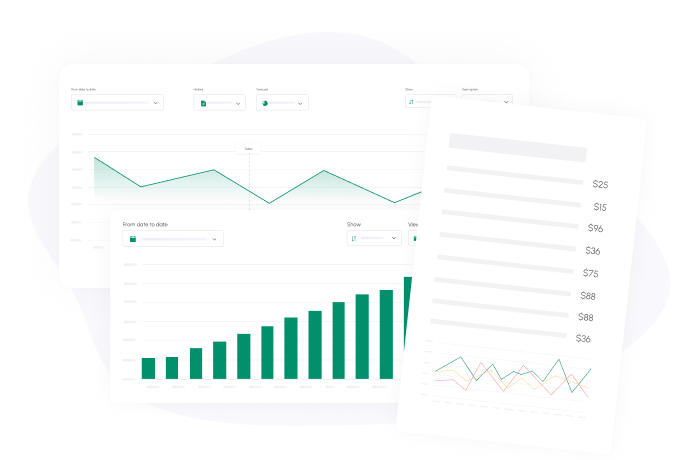

Businesses have two main types of assets:
- Tangible assets
- Non-tangible assets
We're going to explain the first asset class so that you can better understand how it pertains to your business.
What are Tangible Assets?
Before we dive into the definition of assets, we need to define “tangible.”
What does tangible mean?
A “thing” that is tangible is an item that you can touch. Assets are things that your business owns. So, based on this, what are tangible assets? These are things that you can touch. Right?
Examples of assets may be:
- Inventory
- Furniture
- Equipment
- Machinery
- Fixtures in a building
- A building
- Land
Non-tangible assets are then “things” that you cannot physically touch, such as your customer list, trademark or patients. You still own these assets, and they may have a value, and they’re valued differently depending on your industry.
A farm can have many non-tangible assets but no one will invest in the company if it doesn’t have land, which is a tangible asset.
However, a software patent for Microsoft can be worth hundreds of millions of dollars and is a main reason for investment.
Importance of Tangible Assets in Financial Management
Tangible assets are important in financial management because they:
- Depreciate in time, leading to tax savings and/or potential losses
- Are often put up as collateral for a loan
- Drive the business’ sales or ability to sell products or services
You can put your building up for collateral to secure a loan. If you fail to make payments, the lender can then seize the building as its own and sell it. You can use tangible assets to secure loans in ways that are much easier than if you only have non-tangible assets to claim.
Valuation of tangible assets is also much easier than with non-tangible assets.
Price comparisons are easier to make with tangible assets. For example, how much is the brand for Nike worth without its assets? One competitor may offer billions just for the right to use the brand name and another may believe it’s worth far less without any assets or patents included.
However, with a tangible item, such as a warehouse, the building can be valued using comparable data in the area for similar warehouses that sold.
Methods for Calculating the Value of Tangible Assets
Tangible assets come in many shapes, sizes and values. If you want to value your assets properly, you need to calculate them using a specific method.
Overview of Valuation Methods
Valuation methods for tangible items often fall within one of the following categories:
- Book value
- Market value
If you’ve ever purchased a used car, you can understand these two values. You can follow Kelly Blue Book and see that your car is worth $10,000, but if everyone is willing to pay $15,000, this is the market value of the asset.
However, book value and market can also relate to the sale of a business and the value provided to the shareholders. For the purpose of this article, we’re not going to cover this form of valuation – just assets without the sale of the company.
Let’s examine the key differences between both valuation methods and what they mean for your business.
Book Value vs. Market Value
Book and market value often pertain to:
- Share value
- Share value when the business is sold
For example, the book value of a business being liquidated is around the amount of the company’s total asset value. However, with assets valuations, you can think of the two as follows:
- Book value: The book value of an asset is how much you paid for the asset minus any depreciation that has occurred. For example, if you paid $100,000 for equipment and depreciation is 40%, the book value of the asset is $60,000.
- Market value: The market value of an asset was touched upon briefly earlier in the article. If you own a rare piece of equipment, the book value may be $100,000 but the market value may be $150,000 due to market conditions and demand.
Book values are often represented on balance sheets because they’re easier to calculate. You can research the asset’s price when sold and calculate how much depreciation has occurred in the time since its purchase.
Accountants can run calculations on these values and determine the total net value of the business’ assets.
The key most important thing to do is to remain consistent with the value calculation that you use. For example, if you run a valuation on your land using the book value today, use the same calculation method in the future.
Otherwise, if you jump from one method of valuing tangible assets to another, it’s possible that you’ll skew its true value dramatically.
The Impact of Depreciation on Asset Value
Based on the tangible assets meaning above, it’s easy to understand that the asset’s value may go down in time. For example, imagine a new piece of equipment that is in pristine condition and purchased for $100,000.
You use the equipment for 5 years and while it’s been maintained well, its value is now lower.
Chances are, with age and use, some of the original components are worn and not up to original standards. You may still sell the asset for $75,000 – or any figure - because the buyer still sees value in the equipment.
However, the value is lower due to the asset not being in its original condition.
Depreciation lowers your asset’s value, but depending on your country of operation, you may be able to write-off the value lost on your business taxes. Your asset’s value may also rise thanks to appreciation.
Evaluating Appreciation of Tangible Assets
Evaluating the appreciation of tangible assets can help you understand how much of a return an asset is providing.
Calculating appreciation is generally simple and straightforward:
- Appreciation = Asset’s Current Value – Asset's Purchase Price
The current value is the current market value of the asset, while the purchase price is the acquisition price.
Strategies for Enhancing the Value of Your Tangible Assets
Now that you understand how the value of tangible property is calculated, you may be looking for ways to enhance the value of these assets.
There are a few strategies you can use to boost asset value.
Considerations for Maintenance and Upkeep
One of the best things you can do to enhance the value of your tangible assets is to maintain them. Keep your equipment, buildings and other assets in tip-top shape.
Maintenance and upkeep help preserve the asset’s value while ensuring they run optimally for as long as possible without affecting operations.
Take the time to create an asset maintenance plan that includes:
- A clear set of tasks that need to be carried out
- Instructions for each task
- A timeframe for asset downtime
Additionally, consider whether you’ll need to hire in-house engineers or bring in contractors to help with maintenance.
Making Informed Decisions on Upgrades
At some point, you may have the opportunity to upgrade your assets. Equipment or building upgrades can help increase the value of the asset, but the decision to upgrade should be made carefully.
Consider:
- The cost of upgrading
- The return it will provide
Comparing the cost and return will help you determine whether the upgrade is worth the investment.
Leveraging Tangible Assets as Collateral
Improving asset valuation will make it easier to leverage these assets as collateral when needed. Real estate, inventory, equipment and company vehicles can all be used as collateral if financing is needed.
Selecting Professionals for Accurate Tangible Asset Appraisals
When tangible assets need to be appraised, it is crucial to select the right professional for the job. There are several key things to consider when making this decision, including:
- Qualifications and experience. The appraiser should have experience working with other businesses in your industry and be familiar with the types of assets you want to have appraised.
- Methodology. Which appraisal methodology do they use and why? Make sure that their process follows industry and financial institution standards.
- Independent. To avoid conflicts of interest, the appraiser should not have any vested interest in the sale of the asset.
To find the right professionals, start by asking for recommendations from colleagues or people you trust.
Conclusion
What is a tangible asset? Tangible assets are the backbone of your business. They account for much of your company’s value, yet they are not for sale. They are the buildings, equipment and inventory that help keep your business in operation. That’s why it’s so crucial to ensure they are properly appraised. Taking steps to further improve the value of your tangible assets can also help increase your company’s value over the long term.
Related posts:
You may be interested:
New:












